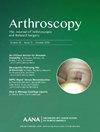大多数在拉塔喷射术后未能重返运动场的运动员都有心理因素:系统回顾。
IF 5.4
1区 医学
Q1 ORTHOPEDICS
Arthroscopy-The Journal of Arthroscopic and Related Surgery
Pub Date : 2025-08-01
DOI:10.1016/j.arthro.2024.11.003
引用次数: 0
摘要
目的:本研究旨在确定接受拉塔杰特手术的运动员重返赛场(RTS)率,同时概述未能重返赛场的具体原因:方法:进行电子文献检索(PubMed/MEDLINE、Scopus、Web of Science)。纳入了同行评审期刊中对运动员进行 Latarjet 手术并报告了 RTS 失败率和原因的研究。仅报告非运动员、非Latarjet手术以及缺少RTS失败率和失败原因的研究除外。研究异质性采用 I2 统计量进行评估,质量评估采用非随机研究方法指数(MINORS)标准:在对 3617 篇文章进行审查后,共有 18 项研究、1066 名患者符合纳入标准。纳入研究的证据级别从 LOE II 到 LOE IV 不等。未重返运动场(NRTS)的比例从 3.4% 到 35.3% 不等。对于运动员未能重返运动场的原因,更多研究提到了与肩无关的原因,而非与肩相关的原因。10项(55.5%)研究报告称,在656名(61.5%)患者中,超过50%的NRTS是由于与肩无关的原因造成的。只有3项(16.7%)研究报告称,100%的NRTS是由于肩部相关原因造成的,其中包括害怕再次受伤和心理因素。研究异质性为中等(I2 = 73.4%; 95% CI: 57.5-83.3; p < 0.001),研究质量令人满意(非比较性研究的平均 MINORS 得分为 12.1,比较性研究的平均 MINORS 得分为 20.5):根据该系统综述,18 项研究显示,Latarjet 术后 NRTS 的发生率从 3.4% 到 35.3% 不等,大多数研究认为与肩部无关的原因(如害怕再次受伤或心理因素)是阻碍患者重返运动场的主要原因:证据级别:IV本文章由计算机程序翻译,如有差异,请以英文原文为准。
Most Athletes Who Fail to Return to Sport After Latarjet Procedure Cite Psychological Factors: A Systematic Review
Purpose
To identify the return-to-sport (RTS) rate in athletes undergoing a Latarjet procedure while outlining the specific reasons for failure to RTS.
Methods
An electronic literature search was conducted (PubMed/MEDLINE, Scopus, Web of Science). Studies in peer-reviewed journals with Latarjet procedures performed on athletes that reported rates and reasons for failure to RTS were included. Excluded studies were those that reported solely on nonathletes, non-Latarjet surgery, and missing rates of and reasons for failure to RTS. Study heterogeneity was assessed using the I2 statistic, and quality assessment was performed using the Methodological Index for Non-Randomized Studies criteria.
Results
After review of 3,617 articles, a total of 18 studies with 1,066 patients met the inclusion criteria. The level of evidence for included studies ranged from II to IV. Rates of not returning to sports (NRTS) ranged from 3.4% to 35.3%. More studies cited shoulder-unrelated reasons than shoulder-related reasons for why athletes failed to RTS. Ten (55.5%) studies, making up 656 (61.5%) patients, reported that shoulder-unrelated reasons were accountable for more than 50% of NRTS. Only 3 (16.7%) studies reported 100% NRTS because of shoulder-related reasons, which include fear of reinjury and psychological factors. Study heterogeneity was found to be moderate (I2 = 73.4%; 95% confidence interval 57.5-83.3; P < .001) and study quality was found to be satisfactory (mean Methodological Index for Non-Randomized Studies score 12.1 for noncomparative and 20.5 for comparative studies).
Conclusions
According to this systematic review, the rate of NRTS after Latarjet ranged from 3.4% to 35.3% across 18 studies, with the majority of studies citing nonshoulder-related reasons such as fear or reinjury or psychological factors as the major deterrent for returning to sports.
Level of Evidence
Level IV, systematic review of Level II to IV studies.
求助全文
通过发布文献求助,成功后即可免费获取论文全文。
去求助
来源期刊
CiteScore
9.30
自引率
17.00%
发文量
555
审稿时长
58 days
期刊介绍:
Nowhere is minimally invasive surgery explained better than in Arthroscopy, the leading peer-reviewed journal in the field. Every issue enables you to put into perspective the usefulness of the various emerging arthroscopic techniques. The advantages and disadvantages of these methods -- along with their applications in various situations -- are discussed in relation to their efficiency, efficacy and cost benefit. As a special incentive, paid subscribers also receive access to the journal expanded website.

 求助内容:
求助内容: 应助结果提醒方式:
应助结果提醒方式:


